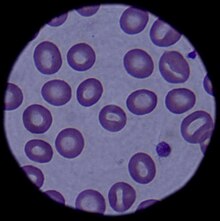Blood cell

A blood cell, also called a hematocyte, is a cell of any type normally found in blood. In mammals, these fall into three general categories:
- red blood cells — Erythrocytes
- white blood cells — Leukocytes
- platelets — Thrombocytes
Together, these three kinds of blood cells sum up for a total 45% of blood tissue by volume (and the remaining 55% is plasma).[1] This is called the hematocrit and can be determined by centrifuge or flow cytometry.
Types
Red blood cells (Erythrocytes)
Red blood cells are primarily for carrying oxygen and some carbon dioxide through the use of hemglobin and have a lifetime of about 120 days. In the process of being formed they go through being a stem cell, a monopotent stem cell, a Proerythroblast, reticulocyte, and then becomes a red blood cell.carrying glucose
White blood cells (Leukocytes)
White blood cells are part of the innate immune system and have a lifetime of a few days to year. A few viruses such as the HIV virus cannot be fought.
Platelets (Thrombocytes)
Platelets are involved in blood coagulation and have a lifetime of about 9 days. They form from stem cells. [2].
References
- ^ Maton, Anthea (1993). Human Biology and Health. Englewood Cliffs, New Jersey, USA: Prentice Hall. ISBN 0-13-981176-1.
{{cite book}}: Unknown parameter|coauthors=ignored (|author=suggested) (help) - ^ http://www3.interscience.wiley.com/journal/119622203/abstract
External links
- What is Blood? from the Genetic Science Learning Center at the University of Utah.
- Cells of the blood
